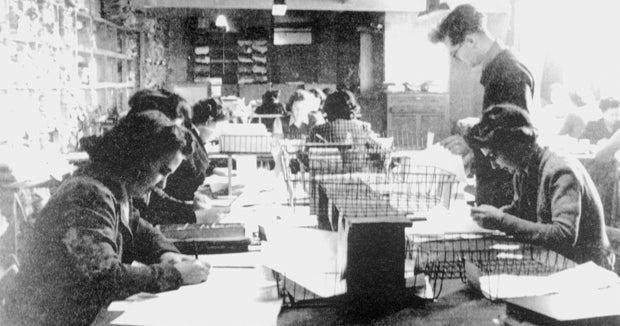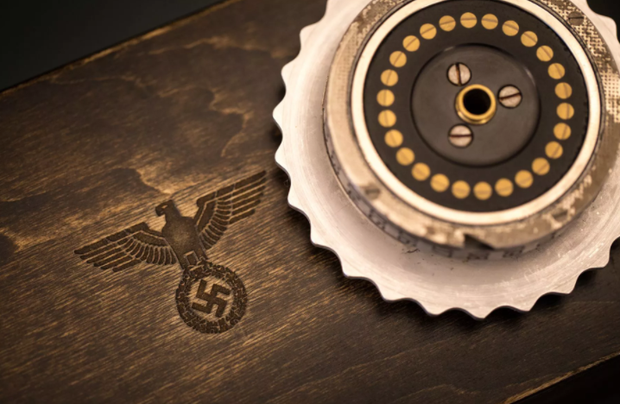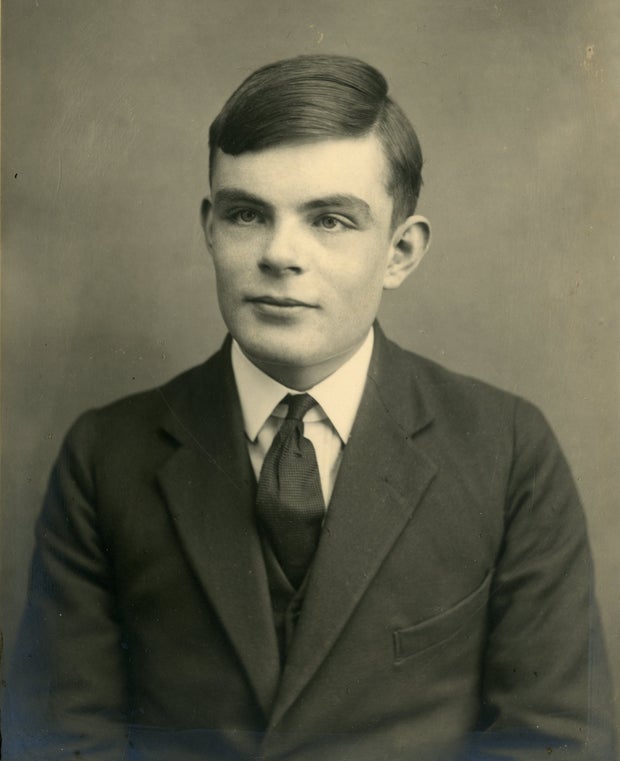CBS News
Secret army of women who broke Nazi codes get belated recognition for WWII work

During World War II, dozens of women students at Cambridge University worked around the clock in complete secrecy to crack Nazi codes, but only now are the unsung heroes getting recognition.
At least 77 students from the women-only Newnham College were drafted to Bletchley Park, the code-breaking center north of London, during the conflict.
It was there that mathematician Alan Turing decoded messages encrypted by the Nazis’ Enigma machine, in particular those sent by German U-boats submarines in the North Atlantic. Enigma cyphers were used by the Germans during World War II to scramble military communications and intelligence, to such an extent that they trusted their code was unbreakable.
Historians widely acknowledge that Bletchley played a key role in bringing down Adolf Hitler. The team that worked in the secret installation outside of London is credited not only with cracking Enigma, but also the Lorenz, another device that the Nazi high command used to send coded messages.
But the story of the Cambridge women has only recently been revealed, thanks to research started by Sally Waugh five years ago. She worked with historian Gillian Sutherland and archivist Frieda Midgley to uncover the names of the Bletchley Park recruits from Newnham College, the BBC reported.
Andrew Hoyle/CNET
Waugh, a 69-year-old former Newnham student and teacher, said she wanted to highlight the role of women during World War II, often ignored in history books.
“Nobody was ever able to say thank you,” she told AFP. “I had no idea that people from Newnham went to work at Bletchley Park”.
Then, one day, she came across an article mentioning the name of an old friend, Jane Monroe, who died in 2005.
When Monroe, a mathematician from Newnham, was asked what she had done during the war, she replied unfazed: “Oh, I made tea,” said Waugh.
“She was in reality a code breaker. She was a friend but she didn’t tell me,” Waugh explained.
Monroe was unable to talk about her role as she had signed the Official Secrets Act, which restricts the publication of government information deemed sensitive.
The article mentioned three other women, whom Waugh tracked down in the university’s archives.
“I thought, if there are four of them, I wonder if there are any more?” she recalled.
The Sherborne School
In fact, Waugh found around 20 names and then cross-referenced her information with Bletchley Park.
Together they were able to identify almost 80 women.
“Everything was quite mad, really”
The only one whose name has so far gone down in history is mathematician Joan Clarke, who was recruited in 1940 and worked with the celebrated Enigma decoder and computer scientist Turing, to whom she was briefly engaged.
She became deputy head of her unit and after the war continued to work in intelligence. Keira Knightley won an Oscar nomination for her portrayal of Clarke in the 2014 film “The Imitation Game.”
Also on the list is Violet Cane, another mathematician with a gift for statistics. She worked at Bletchley’s naval section between 1942 and 1945. Another code breaker, Mavis Batey, spoke to CBS News in 2008, when she was 87, about working at Bletchley Park.
“Everything was quite mad, really,” said Batey, who was responsible for decoding a message that revealed the date of a planned Italian naval attack and, in turn, allowed the British to prepare.
German speaker Elizabeth Langstaff was given the tasks of reconstructing German messages from raw decryptions, interpreting abbreviations and analyzing the results over months.
Three women — Alda Milner-Barry, Pernel Strachey and Ray Strachey — helped recruit women to Bletchley Park from Newnham College, the BBC reported. Milner-Barry by then had been a fellow and vice principal at the school, and her brother belonged to one of the government code and cypher school groups at the Bletchley code breaking station. Pernel Strachey was the Newnham principal, and her brother was an expert in deciphering coded messages, according to the BBC.
At the end of 2023, a letter was uncovered dated Jan. 28, 1939, in which the principal of the university confirmed to Bletchley Park that “in the event of emergency we should be able to find for you about six students proficient in Modern Languages, in order for work to be carried out at the Foreign Office.”
Newnham, which was founded in 1871, eventually sent Bletchley mathematicians, linguists, historians and even archaeologists to analyze aerial photographs.
“Newnham women were represented in most key areas of Bletchley Park’s work,” Jonathan Byrne, Oral History Officer at Bletchley Park Trust, told AFP.
That included decrypting German signals encrypted by Enigma, producing intelligence reports, understanding the activities of the Nazis by analysing signal networks and studying diplomatic signals.
Around 50 of women were believed to have been on duty on June 6, 1944 — “D-Day”, when Allied forces landed on the beaches of Nazi-occupied northern France.
“Although the work they were involved in contributed to Allied planning for the liberation, most would have not known when the invasion was happening,” explained Byrne, though some may have suspected.
“German signal traffic in France increased in response to the invasion, making early June 1944 a busy time at Bletchley Park,” he explained.
CBS News
Trump says America is “like a garbage can” at campaign rally

Watch CBS News
Be the first to know
Get browser notifications for breaking news, live events, and exclusive reporting.
CBS News
Is a reverse mortgage or home equity loan better for seniors? Experts weigh in

Getty Images/iStockphoto
Record-high inflation in the post-pandemic era has been challenging for many Americans, but retirees often face added struggles as prices rise since many are on a fixed income. That’s why it comes as no surprise that 59% of retirees expressed concerns about their financial security, according to a survey conducted by MedicareFAQ.
The good news is that many seniors have a significant source of funds to draw from in their home equity. In fact, for seniors 65 and over, the median value of their home equity is $250,000. That’s a 47% increase in the value of equity since before the pandemic.
Older Americans who need extra funds can tap this equity to help make ends meet, and they have different ways to do it including a home equity loan and a reverse mortgage. There are important differences between home equity loans vs. reverse mortgages, though, so retirees must do more than just compare today’s home equity interest rates to decide which is best.
This guide will help you understand when a reverse mortgage makes sense and when you should opt for a home equity loan instead.
Find out more about your home equity loan options here.
When a reverse mortgage is better for seniors
Reverse mortgages use your home as collateral, just as traditional mortgage loans do — but they work very differently. That’s because you don’t send in monthly payments with a reverse mortgage. Instead, your lender sends money to you and your loan balance grows each month. When you pass away or move, the reverse mortgage must be paid back.
“A reverse mortgage is intended for borrowers over age 62 that are not able to afford their monthly payments using their current retirement income and need additional income to help with their responsibilities,” says Lisa Gaffikin, a home loan specialist at Churchill Mortgage.
Gaffikin says that if you have limited income, you may not qualify for a traditional home equity loan but a reverse mortgage could be an option. You’ll get to stay in your home without adding to your monthly obligations, while also being able to supplement your current income.
You do need to have sufficient equity in your home though, and will need to follow requirements including continuing to maintain the property over time.
“Reverse mortgages are ideal for seniors who are house-rich but cash-poor,” says Josh Lewis, a certified mortgage consultant and host of The Educated Homebuyer.
Lewis also addressed a common concern seniors have about reverse mortgages: the ability to leave property to loved ones when you pass away, which could be impacted by the fact the loan must be paid upon your death.
“There’s a misconception that you won’t have a home to leave to your heirs but that is not true,” Lewis says. “You’ll have a home, but the equity your heirs inherit will depend on how long you live and how your home appreciates over time. It’s truly no different than inheriting a home with a traditional mortgage, except the loan balance will need to be paid off through a refinance or sale within six to 12 months of the homeowner’s passing.”
Learn about how a home equity loan could benefit you today.
When a home equity loan is better for seniors
Home equity loans work differently than reverse mortgages. You’ll still need equity and must use your home as collateral, but you receive the borrowed funds upfront when you take out the loan and you must start making payments on the debt immediately.
“Home equity loans are ideal when you need a lump sum and can handle monthly payments,” Lewis says. “With lower upfront costs and typically lower interest rates, they’re perfect if you want to keep building equity and might sell or pass on your home soon. This option works well for those with a steady income who are looking to borrow for a specific purpose.”
The key thing to remember, though, is that you must qualify by showing the lender you have enough money to afford the loan payments and you must be able to make those payments for the duration of the loan term. This isn’t always easy when you need extra cash.
“A home equity loan might be a better option if the homeowner is not struggling to make current payments and only needs equity from the home to consolidate non-property debts or to lower monthly expenses for liabilities with higher interest rates,” Gaffikin says. “If the borrower is comfortable with their housing expenses and can make the current housing-related payments and the new home equity loan payment, a home equity loan might very well be the best choice.”
Gaffikin recommends looking at your full financial picture and considering the long-term implications of your decision when deciding which is right for you.
The bottom line
Ultimately, if you want to access equity with no monthly payments and are OK with leaving less equity to your heirs, a reverse mortgage is likely the better option and you should shop carefully to find the best reverse mortgage companies to minimize interest and fees. If you’d rather pay back your loan during your lifetime and can afford it, a HELOC is the better choice.
CBS News
New York Liberty celebrated with ticker-tape parade after historic WNBA championship

Watch CBS News
Be the first to know
Get browser notifications for breaking news, live events, and exclusive reporting.











